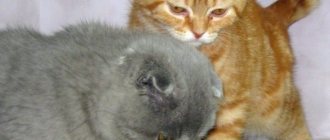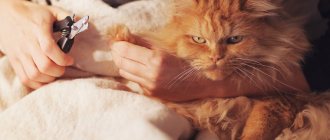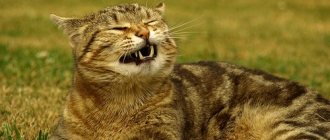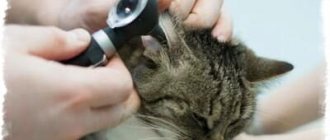Under natural conditions, animals quietly get rid of keratinized particles in the process of moving on hard surfaces, while climbing trees, hunting, etc. At home, pets do not have this opportunity, therefore, if the cat is not accustomed to a scratching post, furniture, etc., are used. walls, carpets.
Do not rush to punish the fluffy - just carry out hygienic trimming of the claws. It is performed using a special tool - a nail clipper. You can find several types of this device in pet stores.
Why do you need to do a cat manicure?
Cats' claws invariably grow, and they need to be tidied up - trimmed using a special nail clipper. Overgrown claws can cause discomfort to the animal or cause injury.
In nature, cats walk on hard surfaces or wear down their claws on trees and other convenient objects. At home, animals are deprived of this opportunity and cannot do without human help. Therefore, from time to time they need the so-called cat “manicure”.
Overgrown claws can become ingrown or cause discomfort when walking. The cat may also get caught in a carpet loop or some piece of furniture, which will lead to a finger injury and medical intervention.
When their claws grow long enough, cats begin to grind them down themselves. In the best case – on a scratching post, in the worst – on wallpaper or furniture. Timely manicure is the key to the cat’s health and the integrity of the owner’s sofa.
Recommendations if your dog is bleeding
If you accidentally cut off part of the pulp, the animal twitched and was injured, or worse, the claw was completely torn out, then act quickly. Do not panic yourself, try to calm the howling dog - give it the most delicious treat.
After this, immediately take out dry potassium permanganate or talc, put it on gauze and apply to the wound for a minute to stop the bleeding. Afterwards, apply ice wrapped in cotton cloth for a short time. If there are severe tears, fill the wound with novocaine.
Do not let the animal run and hide - immediately disinfect the wound!
If the wound is serious and the animal is crying, then immediately go to the veterinary clinic or call a doctor at home.
What is a claw cutter
People use nail scissors to take care of their nails. And for cats there is a special accessory - a nail clipper. It differs from nail scissors both visually and functionally. The appearance of a nail clipper depends on the type, although they are all roughly similar. Only the electric nail grinder is radically different.
Description of the tool
There are four types of cat nail clippers. Each one has its own individual appearance and nuances of working with it.
In a veterinary pharmacy or pet store, you will immediately recognize nail cutters: these are small pruning scissors, the blades of which have a recess for the claw. Well, the grinder looks like a plastic handle with a small rod that rotates at high speed and grinds down the claw.
It is optimal to choose a tool with a handle that is comfortable for you: it fits in size, does not slip, and does not squeeze your fingers. The blades must be serrated, sharp, smooth and shiny.
Why regular manicure accessories are not suitable
A human nail and a cat's claw have different structures and densities, which is why different care products are selected. The nail is a plate that does not itself have nerve endings and blood vessels, so when cutting, only the skin and tissue of the finger can be damaged.
The cat's claw has a hollow structure and a crescent-shaped curve. It contains blood vessels and nerve endings that are very easy to damage, causing pain and bleeding. It is much easier to injure a cat with ordinary scissors than with a nail clipper.
Another caveat: human scissors or wire cutters tear apart a cat’s claw, which leads to problems ranging from crumbling to bleeding or ingrown nails. The nail cutter cuts the plate more evenly and sharply, so the claw does not peel off.
Before you begin the nail trimming process, it is important to familiarize yourself with the basic anatomy of a cat's claw and paw and learn how to correctly determine the length that needs to be left.
Alternative options
If you don’t have the right tool at hand, you can use nail clippers or regular scissors with sharp blades. Before the procedure, instruments must be disinfected with alcohol or chlorhexidine.
I trim my cat's claws with my own tweezers; I didn't buy a nail clipper separately.
Alexander Chichaev
https://www.petshop.ru/forum/?PAGE_NAME=read&FID=30&TID=2346&buf_fid=31&PAGEN_1=2
In the future, it is still recommended to purchase special tools for removing the stratum corneum, since cutting will need to be done regularly and repeatedly.
How not to cut your nails
Nails should not be trimmed with nail scissors intended for human use. A person's nail plate is much thinner than a cat's, so this tool is ineffective here. At best, it will simply break; at worst, it will damage the claw, which will lead to further delamination.
Types of devices
There are variations of nail clippers of different types, models, shapes and designs. There are some that are very easy to use - they are suitable for novice cat owners, and there are special ones designed for professional breeders and groomers.
Before going to the store, it is better to find out what the differences are between the main types of nail clippers, as well as their advantages and disadvantages.
Guillotine
This type of tool consists of two working parts: movable and fixed. Trimming is performed by a moving part, which is installed perpendicular to the claw placed in a special hole. The use of guillotine claw clippers requires certain skills, since when fixing the nail plate it is not visible. However, despite this disadvantage, guillotine-type tools are very popular - especially among owners of large cats with hard claws.
Scissor nail clipper
Scissors are the simplest solution. Outwardly, they resemble human manicures, only with rounded blades and a hole in the middle. It is intended for laying the claw and fixing it during the procedure.
The tool is very easy to use: you place a cat's claw in the notch, the handles close together, and the result is a neat, smooth cut. Suitable for small cats and kittens.
Nail clipper-secateurs
Resembles regular wire cutters or needle nose pliers. The handles have rubber linings, fit comfortably in the hand and do not slip. The spring included in the mechanism also makes working with the accessory easier. The cut is better than that of scissors.
Most models are equipped with a special limiter that sets a certain length and protects against cutting off excess. A special safety lock blocks the cutting surfaces when the pliers are not in use. There are straight and curved models on the pet products market.
Electric nail clipper or grinder
This is a power tool, so it is the most functional and expensive. During operation, the grinder head with an abrasive coating rotates and grinds down the claw plate like a nail file. The device comes with various attachments and limiters.
A beginner without the skill of working with an electric grinder can easily injure a pet by affecting the living part of the claw. Such devices are more often used in professional grooming salons. In stores you can find models that operate on mains power, batteries, and rechargeable batteries.
Why does a cat need a nail clipper?
Domestic cats are small predators, ready to fend for themselves in any dangerous situation. Sharp claws allow the animal to persistently fight off the offender. Loyal pets will never hurt their owner or other family members. They can accidentally scratch a loved one only by playing too hard. Even a small kitten, in the process of exciting games, can painfully injure human skin with its claws.
To avoid such misunderstandings, owners are advised to periodically trim their pet's growing claws. This will also preserve the integrity of the furniture upholstery and save the carpet, walls with wallpaper and other property in the house from damage.
To trim cat claws, it is better to use a special device - a nail clipper. A professional tool designed to cut the strong claws of domestic predators will make the trimming process quick and absolutely safe.
How to choose a nail clipper for cats
It’s best to choose a nail clipper for cats this way: whichever tool is convenient for the owner, that’s what you should buy. If the nail cutter fits well in your hand, misfires and injuries will be reduced to almost zero.
The second important point is the size of the cat and, accordingly, the size of its claws. For thin and transparent claws, on which the vessels are clearly visible, you can use scissors or nippers. If the claws are thick and large, you must use a guillotine or grinder.
The tool must be of high quality, and its blades must be dense and made of good steel. The nail clipper should not seem too light or heavy to the owner, as this can cause inconvenience and awkward movements during cutting.
TOP 7 leading models
A cat nail clipper is a useful thing in the home of every kitten owner. In order not to get confused by the abundance of offers, check out the rating of popular models. Their quality has been tested by thousands of buyers and experts. Different functional characteristics will help you choose the right option.
- Trixie (Germany). European quality is embodied in a metal guillotine for cutting cat claws. Strict design, decent sharpening and increased comfort due to anti-slip materials have made the brand a favorite among pet owners. Price: 350 rub.
- Papillon (Netherlands). Nippers or nippers made by a Dutch manufacturer. They gained popularity due to high-quality steel and a comfortable handle design. Manufacturers also took care of safety by including a blade blocker in the model. The limiter ensures that the nail plate is cut to the required length. Price: 380 rub.
- Zolux (France). Scissors in their classic design with round notches at the tips of the blades. Made in large and small sizes. Made of stainless steel, comfortable thermoplastic rubber handle, non-slip. When developing the mechanism, the anatomical features of cats were taken into account. There is no risk of injury. Minus - not suitable for kittens. Dimensions: 7 x 14 cm. Price: 360 rub.
- Dezzie (China). The guillotine-type nail clipper is made of plastic (handle) and stainless steel. It has a claw catcher that prevents clipped pieces from being scattered around the room. Dimensions: 15.8 x 8 x 2 cm. Price: 420 rub.
- Hello Pet (China). Universal guillotine (the tool is suitable for cats, dogs, rabbits, birds). Material: heat-resistant stainless steel. The very sharp blades allow you to safely cut even the thin nails of young cats. The animal does not feel discomfort when handled correctly (cutting off the very tip). Dimensions: 25 x 10 x 2 cm. Price: 230 rub.
- Hagen le salon (Germany). Miniature scissors are beginner-friendly. Due to the size, they are suitable for adult cats and kittens (but claws that are too rough may not be suitable for them). The handles are treated with anti-slip material, so you don’t have to worry about them breaking. Dimensions: 12.5 x 10 x 1.5 cm. Price: 300 rub.
- Codos "CP-3300" (China). Electric grinder for professional use, suitable for salon and home use. It is also used to grind down the teeth of rabbits. Has high power, 2 nozzles. Works both from the network and from a built-in battery with a capacity of 2.4V 450mAh (enough for 3 hours of continuous operation). It charges in 2 hours, has a “Russian” plug, and is light weight (114 g). Convenient to use. Price: 2350 rub.
So, to choose a nail clipper for cats and carry out the procedure correctly, follow simple recommendations
To make your choice easier, pay attention to the proposed list of quality products. Accustom your kitten to manicure “from a young age” so that he gets used to cutting his claws from childhood, and he does not associate the procedure with fear and torment.
Using a nail clipper
A nail clipper should be beneficial for cats and their owners, eliminating harm and stress. To do this, the owner must be fully prepared for the procedure himself. The cat needs to be reassured and ensured that it is feeling well.
Nail trimming procedure
Before starting the procedure, you must wash your hands, your pet’s paws, and also disinfect the nail clipper itself. Next, proceed according to the steps:
- The cat should be calm. If there are signs of illness, it is better to postpone the procedure until better times. You should not cut the nails of an animal that has just eaten or is scared - it may vomit. If the cat gets nervous and struggles, it will jerk its paw and damage a claw or finger.
- It is better to pick up the cat, calmly talk to it and stroke it. This will make her more comfortable. At this point you can begin the procedure.
- The nail cutter is taken in the hand so that it fits comfortably and tightly, and it is easy for the person to control all movements. It is better to take the paw in such a way as not to pinch your fingers and not cause discomfort to the cat, acting gently but confidently.
- To make the claws clearly visible, you need to gently press the pad on the paw in the very center: the claw will come out slightly.
- Next, it is important to determine where the capillaries and nerve endings are located in the nail. To do this, you need to look at the claw in good lighting: this part will be pink. In black cats it may be brownish.
- You can cut off the entire transparent part of the claw, just short of the pink part.
It is better to file the edge with a file or buff so that there are no rough edges or nicks left.
Precautions and possible injuries
It is important to carry out the procedure cleanly and in good lighting so that the “living” part of the claw can be seen. If it is damaged, blood may bleed and the cat will be in pain, so you need to retreat 2-4 millimeters from this place.
In case of severe bleeding, immediately apply a tight bandage and, without wasting time, contact your veterinarian. Mild bleeding can be stopped with hydrogen peroxide.
If your cat has an ingrown claw, you should not try to deal with this problem on your own - it is better to immediately contact a specialist. A good grooming salon or any veterinary clinic will eliminate this nuisance.
Tool storage
A nail clipper can be classified as a pair of scissors or nippers. Due to the presence of blades, the tool is dangerous, even if it has a locking mechanism. It is better to keep it away from children and animals to avoid injuries and accidents.
The nail clipper does not require special storage conditions, but you should not place it with objects that could damage the blades. It is also recommended to keep it away from water and damp places.
Tips and tricks
- If your cat is restless, it is better to trim the ends with an assistant who will hold the pet directly while you hold the paw and use the nail clipper.
- Do not undertake the procedure if your pet is acting out or is clearly out of sorts - it is better to cut the ends when the animal is half asleep or calm.
- On average, the haircut needs to be repeated every 2-3 weeks, as the claws grow.
- You should start doing such procedures, if possible, from an early age - this way the pet will get used to unpleasant sessions and will take them for granted, inevitable and requiring patience.
- If you have injured the pink part of the claw and the bleeding does not stop for a long time, take your pet to the veterinarian.
A cat nail clipper is certainly a very useful tool that allows you to quickly and efficiently care for your furry pets. To ensure that the process of trimming claws does not cause inconvenience to either you or the cat, you need to choose a high-quality, sharp and easy-to-use tool for your pet that will serve you for many years.
Features of nail trimming
Claw trimming is a controversial procedure that causes a lot of controversy and debate among veterinarians and pet owners. Some argue that this is necessary, others believe that subjecting a cat to such executions is inhumane and makes no sense. In reality, each animal requires an individual approach. There are cases when trimming nails helps prevent the occurrence of pathologies and ensures full functioning.
A little anatomy
To understand the essence of the nail trimming procedure, you need to familiarize yourself with some anatomical features. The cat's toe has a specific structure: it consists of several phalanges (the last one ends in a claw), blood vessels, nerve endings, joints and muscles. The claw is tightened by a special tendon, which is located in the upper part of each finger. In a calm and relaxed state, the claws are hidden in the folds of the paws; in an excited state, they appear outside. The crescent shape of the claw allows the animal to tenaciously grab prey (literally “keep it on the hook”) and defend itself from enemies.
When a cat is in a relaxed state, its claw is hidden inside the folds
The visible part of the claw consists of two parts: “living” (the pulp, located at the base) and keratinized (the tip of the claw). The “living” area is replete with blood vessels and nerve endings, so any damage to it is accompanied by painful sensations for the cat. The stratum corneum is constantly renewed throughout life. By grinding its claws off on objects, the pet frees itself from the dead old cover (the owners have probably noticed more than once the claws left by the cat in the upholstery of upholstered furniture or a scratching post).
It is thanks to the tendon that the cat is able to retract and extend its claws
The essence of the hygienic procedure is to remove the stratum corneum without affecting the pulp. Otherwise, the animal will be injured and will need several days to recover. Also, we should not forget that trimming nails in any case gives the pet discomfort and unpleasant sensations, even if only dead areas are trimmed. This is due to the presence of nerve endings.
It is necessary to cut off only the top layer, departing from the pulp at least 2 mm
Disadvantages of the procedure
In addition to the unpleasant sensations, there is another compelling argument against. The fact is that claws are the main tool of the animal’s life: with their help, the pet climbs a tree or cabinet, defends itself, and gets food. After the hygiene procedure, the animal, out of habit, trying to climb to a height, may fall and get injured. Cats that are allowed outside by their owners are at particular risk because they cannot defend themselves if attacked by other animals.
When to trim nails
A hygienic procedure is necessary in the following cases:
- before mating and exhibition. In the first option, cutting is necessary so that the animal does not injure its partner; in the second, it is a mandatory requirement according to the competition regulations;
- in case of excessive growth of the stratum corneum. Typically, a similar problem occurs in Sphynx cats and Persian breeds. Due to a deficiency of vitamins D and B in the body, the horny part peels off. Untimely removal of the dead part leads to the fact that the pet clings to the pile of the carpet, sofas and, as a result, can either tear off a claw, damaging the “living” part, or accidentally dislocate its paw;
- when an animal, due to old age or illness, cannot sharpen its claws on its own. In this case, the procedure is necessary, since the claws can grow in different directions and painfully dig into the pads of the paws. An ingrown claw is a serious pathology when surgical intervention is inevitable. The animal cannot move independently due to severe pain, and the wound often bleeds.
Cats have a fifth, vestigial claw on their front paws. It is difficult for them to cling to something, so the stratum corneum here is much longer than on the other paws. The owner needs to control and trim the dead part in a timely manner so that the claw does not penetrate into the pad.
On a rudimentary claw (it is located separately from other fingers), the stratum corneum grows faster










